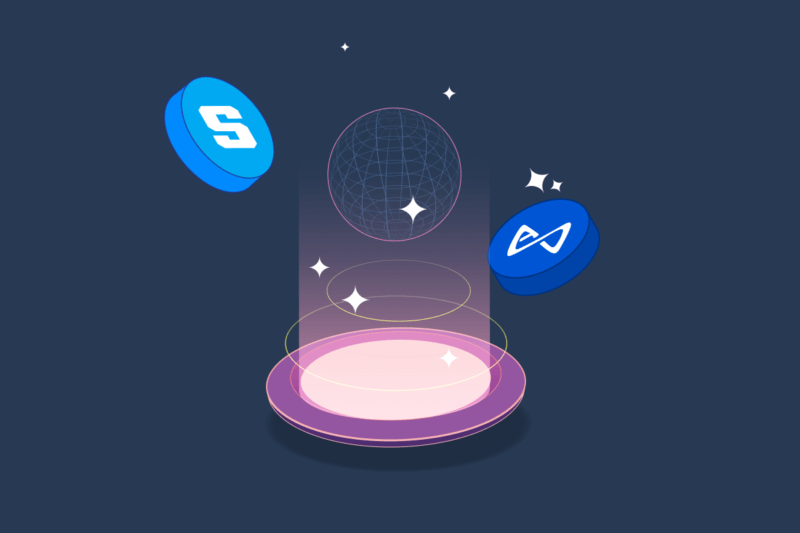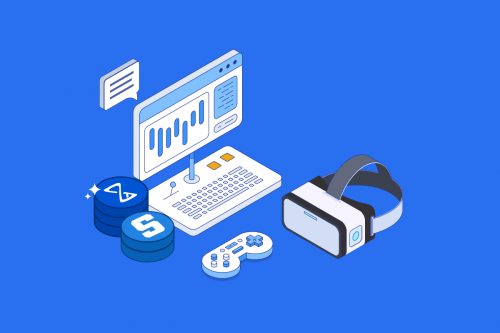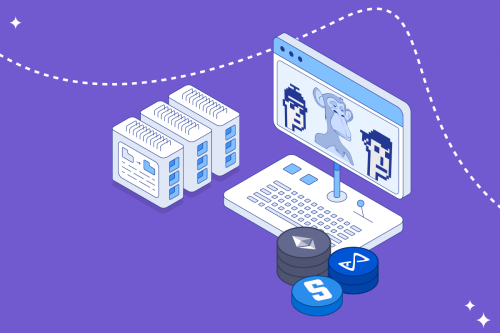
The metaverse. It’s a concept that has been around for three decades and continues to evolve. The progression of blockchain technology has unlocked a swathe of exciting new possibilities for modern-day metaverses. Several promising new projects are changing how humans interact with their finances, friends, and the world around them. The concept of an immersive virtual reality is tied to cryptocurrency, NFTs, and DAOs. This article will traverse some of the past, present, and future metaverse projects that are revolutionising the crypto space.
What is the metaverse?
The metaverse is more of an idea than a tangible “thing”. It’s an online network that connects people to a sprawling, virtual world without the ordinary limitations of society. Those in the metaverse can play games, trade items, and even sit down to enjoy a coffee in a cafe. The metaverse intends to be an immersive space on the internet.

As of now, the metaverse exists as various, disconnected online spaces. Ultimately, the metaverse is idealised as a single hub connecting these spaces and allowing for a seamless transition between virtual worlds.
Tip
The exact definition of a metaverse has changed over time. A common misconception is that metaverse users need virtual reality goggles to participate. In the future, this may be true. However, experts have argued that immersive Role-Playing Games (RPG) and survival games like Second Life, Minecraft, and Roblox are all differing renditions of a metaverse.
Most fascinating metaverse crypto projects
1. Decentraland

Decentraland is one of the most popular metaverse crypto projects, hosting a user base of over 300,000 active members. The application is a sprawling, community-built digital world that allows participants to interact with others across the globe.
The premise of Decentraland begins with a custom-made avatar. Users create characters that can explore the digital plains of Decentraland, play mini-games, enjoy experiences, or create a budding real estate empire.
The key to Decentraland being a metaverse as opposed to any other life simulator game is its thorough in-game economy. The platform is built atop Ethereum’s blockchain and uses two key tokens – MANA and LAND. MANA is just like any other cryptocurrency and can be used to buy items or in-game experiences. For example, someone might pay an entry fee in MANA to explore a Haunted House, just like they would in reality. You can buy MANA from the Swyftx crypto exchange with low fees and slippage.
LAND is an NFT token that gives holders ownership of property in Decentraland. LAND holders can then build on this asset in a variety of ways. It could become a social hub for an online community or an artistic experience they can monetise.
Decentraland aims to simulate real-life experiences through a digital medium. Users can visit coffee shops with friends, buy fine art NFTs from galleries, or view billboards in prominent advertisement districts.
Did you know: An individual paid $450,000 USD on a single Land to be neighbours with famous musician Snoop Dogg.
2. The Sandbox

The Sandbox developers were around long before moving their franchise into the metaverse, offering two mobile games, The Sandbox (2011) and The Sandbox Evolution (2016), that combined had more than 40 million downloads. The creative team recognised the potential for moving their platform onto the blockchain and providing players an avenue to own their content through NFTs and digital assets.
The Sandbox works much like other modern-day metaverses (notably Minecraft) – a mix between an RPG, a life simulator, and a construction game. Players can trawl through mountains of content, worlds, and games created by other users. The Sandbox is more focused on providing gameplay than social events, and members can use Game Maker to create unique content for free. However, there is still a social element to the game, as stars like Paris Hilton host virtual parties and NFT giveaways on the platform.
The Sandbox virtual space is made up of Lego-like objects called Voxels. Voxels are essentially 3D pixels that give games like Minecraft their blocky art style. The Sandbox provides free voxel editing software that members can use to create items, art, and avatars. These creations can then be minted as NFTs and monetised on The Sandbox’s marketplace.
The Sandbox’s in-game currency is SAND, an ERC-20 token that uses the Ethereum blockchain. SAND can be earned simply by playing The Sandbox, monetising games and voxel characters, or becoming a property mogul by renting out virtual land to content creators. You can buy SAND tokens from Swyftx with fast verification and low fees.
3. Bloktopia

Bloktopia is a metaverse blockchain project with a twist – it exists within a 21-storey building to commemorate the 21 million Bitcoin that will eventually exist. This design reflects the platform’s over-arching philosophy as an educational platform for players to learn about the world of cryptocurrency. Unity powers Bloktopia, a popular game engine that has birthed successful projects like Pokemon Go, Fall Guys, and Among Us.
Bloktopia’s skyscraper is integrated with augmented reality(AR) and virtual reality (VR) technology, which blends virtual and physical worlds together. Players can put on a pair of goggles and explore the real world. The platform is built like a colossal shopping mall, with each storefront representing a different experience, game, or shop for in-game products.
In its current iteration, each floor of Bloktopia has a different theme. The first floor – where all new players must enter the metaverse – provides an overview of what is happening in the cryptocurrency world. There is an information desk, a board with live prices, and information on upcoming events. Floor six is the Auditorium, packed with interactive videos and experiences hosted by crypto influencers or celebrities. The top floor is known as the Penthouse and hosts gaming activities. The Penthouse lets Bloktopia players fight it out in multiplayer games like Poker.
Bloktopia’s economy revolves around a native utility token, BLOK. Players can use BLOK to interact with experiences and games throughout the metaverse. If someone wants to try their hand at Texas Hold’Em in the Penthouse, they will need some BLOK. Players can use the metaverse token to buy or lease real estate (storefronts) in the skyscraper and advertise in various spaces.
Did You Know?
Bloktopia was created in 2021 by Ross Tavakoli and Paddy Carroll. It is one of the few metaverses to utilise a blockchain network other than Ethereum. The platform is built atop the Polygon network, a layer-2 scaling solution for Ethereum.
4. Star Atlas

Star Atlas is a massively multiplayer online (MMO) metaverse game set in 2620. As its name suggests, the game is a sci-fi entry set in deep space, where users traverse across galaxies, colonise nations and thwart would-be attackers. The metaverse game is built using Solana, one of the fastest blockchains in the sector. Gameplay is hosted by Unreal Engine 5, one of the most popular game builders out there. This gives Star Atlas a huge point of difference from other metaverse projects – the graphics are cinematic in quality.
Many other current metaverses hang their hat on being social, community-driven spaces filled with mini-games and events. Conversely, Star Atlas is a game first and a social experience second. The plotline revolves around three separate fictional factions fighting for control over resources and territory: humans, androids, and aliens. Gameplay is a mix of real-time strategy, exploration, and role-playing.
Star Atlas players are the captains of their ships. They oversee a crew and must find a way to explore the vast expanses of space. Players can participate in activities such as mining resources, establishing trade routes, and warding off attackers.
The economic element of Star Atlas gives further gameplay depth and real-world financial implications. Resources can come from invading a rival, scrapping an abandoned ship, or production on a colonised planet. Each resource found can be mined, refined, and traded among other users. Star Atlas’s economic system allows for a realistic barter system where players can exchange their unique services. For example, a crew controlling a large mining operation might hire a transportation service to assist with delivery.
Star Atlas’ economy relies on two metaverse tokens – ATLAS and POLIS. ATLAS is the game’s native token and is used to interact with the metaverse. This metaverse coin is used for buying NFT equipment that improves a ship, hiring other players to perform tasks, or trading goods. On the other hand, POLIS is used as a governance token to give holders a say in the game’s future direction.
5. Otherside

The Otherside is an interesting metaverse project currently in development. Yuga Labs are creating the impending virtual world – the team responsible for the popular NFT collection Bored Ape Yacht Club (BAYC). The metaverse is slated to operate similarly to others in the space and serve as a community hub for participants in the Bored Ape ecosystem.

The project released its litepaper on the 16th of July 2022, detailing part one of an eleven-part storyline. The Otherside will offer a chronological narrative called “The Voyager’s Journey” – making it a bit like a campaign mode. The story revolves around the Obelisk, an artifact shrouded in mystery. The voyagers (players) will explore the world around the Obelisk, following the storyline and discovering different ways to interact with the world through harvesting, crafting, and trading.
BAYC NFT holders will be able to mint their avatars into the metaverse as playable characters in a MMORPG (massively multiplayer online role-playing game) with a thriving native economy. The Otherside will use ApeCoin as its native token for purchasing in-game items and virtual real estate in the form of land deeds. Although the Otherside metaverse is still in the works, ApeCoin is currently one of the largest metaverse coins in terms of market cap at the time of writing. You can buy ApeCoin from Swyftx, a trusted and secure crypto exchange.
These land deeds (called Otherdeeds) will be traded among players to let them build money-making experiences, mini-games, or resource centres. In essence, those with access to an Otherdeed will become a core component of crafting the Otherside metaverse. This makes the project quite an interesting case study on blockchain-based metaverses. Most modern games are developed from top-to-bottom by a team of coders, writers, and graphic designers. However, Yuga Labs are creating their game “openly”, taking on feedback and building the world alongside community members.
Did You Know?
The Otherside is a particularly ambitious project. Yuga Labs are one of the most prominent players in the NFT industry. They intend to make Otherside “the metaverse of all metaverses”. They are snapping up the IP rights to several well-known NFT collections such as Meebits and Crypto
Punks.
Future of the metaverse
Advances in blockchain and augmented reality technology over the last decade have created a level of optimism that the future of the metaverse is now. Many fascinating projects are already released or in development, shaping the crypto world.
Although the metaverse in its current state is exciting, it is still a fair way away from the idealised concept of a massively connected virtual reality space emulating real life. However, the growth of cryptocurrency has revolutionised how in-game economics can function. As big players in the global metaverse market continue to collaborate, the metaverse may evolve into an unrecognisable space in the coming years.
The ideas thrown forward by projects like Decentraland and The Sandbox might permanently change how society interacts. The metaverse bridges the gap between the internet’s 24/7 connectivity and the dissonance of digital communication. If technology and public interest continue to develop, the potential of the metaverse is near-endless.
Summary
Five years ago, we wouldn’t think we would be able to put on a pair of virtual reality goggles to visit Snoop Dogg’s mansion or monetise our creativity by building a digital 3D experience. These ideas may have seemed far-fetched, but they are now a reality – thanks to the metaverse.
The last two years have rapidly released numerous metaverse projects, games, and worlds. Fresh concepts, possibilities, and realities are being put forward by some of these promising projects. Just how far the metaverse can progress is anybody’s guess. Still, the worlds at our fingertips right now could provide a glimpse into the technology’s potential.
Disclaimer: The information on Swyftx Learn is for general educational purposes only and should not be taken as investment advice, personal recommendation, or an offer of, or solicitation to, buy or sell any assets. It has been prepared without regard to any particular investment objectives or financial situation and does not purport to cover any legal or regulatory requirements. Customers are encouraged to do their own independent research and seek professional advice. Swyftx makes no representation and assumes no liability as to the accuracy or completeness of the content. Any references to past performance are not, and should not be taken as a reliable indicator of future results. Make sure you understand the risks involved in trading before committing any capital. Never risk more than you are prepared to lose. Consider our Terms of Use and Risk Disclosure Statement for more details.
